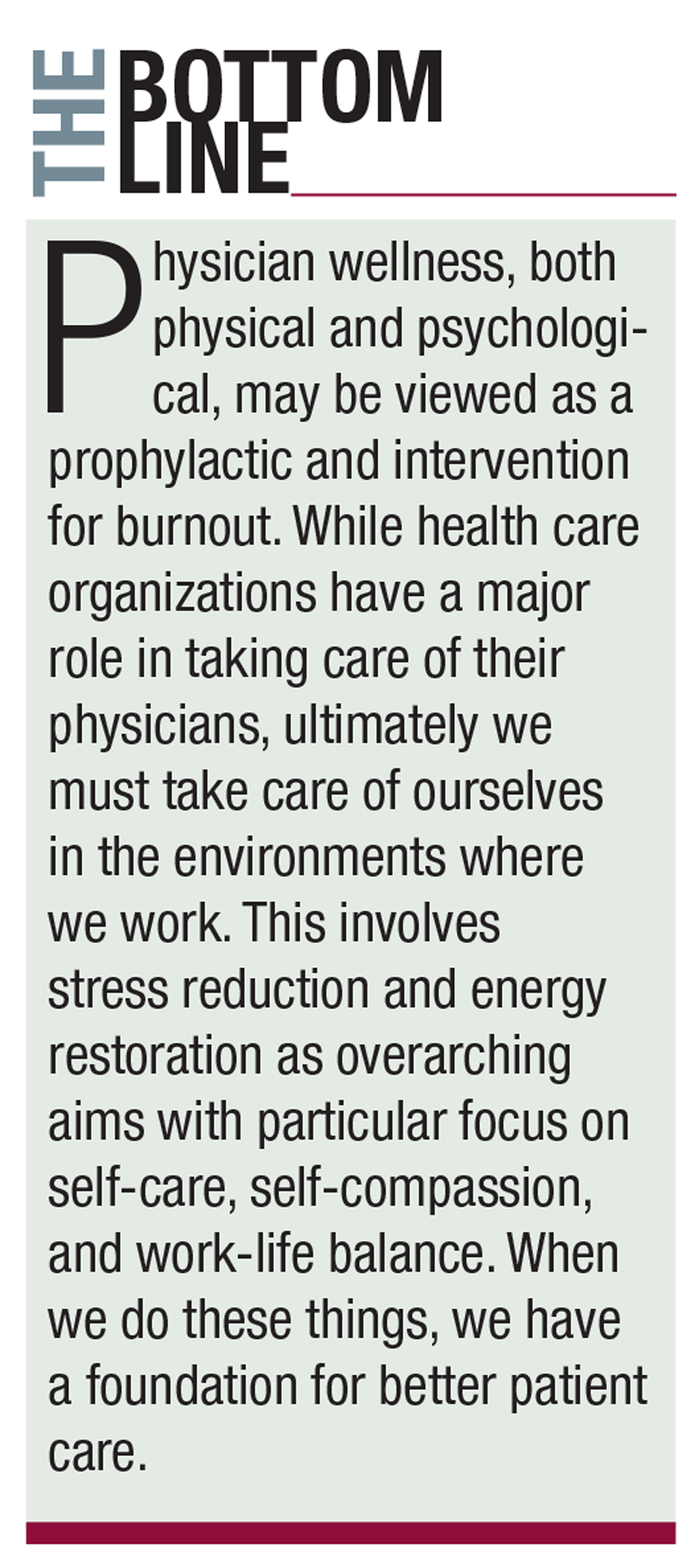Publication
Article
Psychiatric Times
Avoid Burnout With Self-Care and Wellness Strategies
Author(s):
Drained physicians who don't practice self care may harm themselves and their patients. Here's one way to take a breather.

Physician burnout has garnered national interest: a recent study revealed that nearly one-half of physicians report at least one symptom of burnout.1 Psychiatrists are not immune. Long-standing issues include:
• Seeing difficult and complex patients
• Dealing with distressing transference and countertransference issues
• Preventing suicide
• Avoiding malpractice litigation
• Recovering from the trauma of a patient suicide or malpractice suit
• Coping with insurance authorizations
• Balancing work with other life activities
When chronic work-related stress leads to burnout, it signals a need for change and a focus on our own mental health and well-being.
As physicians we’ve always been ambitious and driven: we worked hard to get into medical school and then into the best residencies in our field. We’ve avoided revealing our weaknesses throughout our careers. Consequently, our perfectionism and compulsiveness are reinforced as we derive gratification and self-esteem from our work. These characteristics have served us well to grow and achieve competence in our fields, but perfectionism and compulsiveness cannot reverse burnout, and too often our mental health suffers.
[[{"type":"media","view_mode":"media_crop","fid":"47876","attributes":{"alt":"","class":"media-image media-image-right","id":"media_crop_6614361374538","media_crop_h":"0","media_crop_image_style":"-1","media_crop_instance":"5678","media_crop_rotate":"0","media_crop_scale_h":"268","media_crop_scale_w":"125","media_crop_w":"0","media_crop_x":"0","media_crop_y":"0","style":"font-size: 13.008px; line-height: 1.538em; float: right;","title":" ","typeof":"foaf:Image"}}]]
Establishing and maintaining optimal wellness occurs at both the individual and organizational level. Because institutional change occurs slowly, we do best by starting with ourselves. One therapeutic formula to prevent and address burnout and establish wellness is to reduce stress at work and restore one’s energy at home.2 Each part of the therapeutic formula requires strategies-the simpler the better, because we don’t have time to engage in yet another complex undertaking.
The guiding principles are self-care, self-compassion, and work-life balance. Self-care is necessary to care for others, and self-compassion is necessary to have compassion for others. In other words, we cannot give what we do not have. As George Vaillant wrote, “Usually, the practice of medicine becomes a strain only when physicians ask themselves to give more than they have been given.”3
Self-care
To put ourselves first is considered selfish and certainly not worth marketing-the slogan at many institutions is “patients first.” We are taught, “First, do no harm.” But drained physicians who do not care for themselves may do harm to themselves and their patients. So we also need to learn to “First, do ourselves no harm.”4
It comes as no surprise that self-care consists of the same advice we give our patients: practice good sleep hygiene, develop healthy eating habits, exercise regularly as tolerated, and learn relaxation techniques or meditation. Many of us do not like to be patients, yet scheduling periodic health maintenance, dental, and eye examinations is essential.
Meditation serves dual roles of reducing stress and restoring energy. Mindful breathing is a quick technique for relaxing and re-centering yourself. Take a few moments between patients to sit comfortably in a chair, close your eyes, and pay attention to your breathing and the sensations it creates. If helpful, take a series of slow or deep breaths, feeling the release and relaxation of the cleansing out-breath.
At home, you can extend the mindfulness meditation practice. Although skilled meditation practitioners spend much longer periods of time, getting started does not have to be time-consuming. Establishing the daily habit of meditation or other relaxation techniques is more important than aspiring to be the most skilled. Downloadable guided meditations are freely available (eg, UCLA Mindful Awareness Research Center).5
Unfortunately, the stigma of mental illness and substance use disorders for physicians with these problems contributes to a culture of silence, which prevents them from seeking either treatment or advice from knowledgeable colleagues. Nonadherence to treatment, self-prescribing, and self-medicating with substances are not infrequent in physicians.3
Finally, protecting ourselves in health care systems that often reward, and unintentionally take advantage of, our compulsive willingness to do more work requires learning to say no. At other times, it requires negotiation skills that many of us lack.
Useful self-care strategies include the ability to say no. Make time for restorative activities and learn from your difficulties in practicing self-care. Fill your calendar with activities that restore you, then truthfully say when asked to do something additional, “I’m sorry, my schedule does not permit that.”2
Self-compassion
Self-compassion is a healthy response to our self-criticism when we make mistakes, fall short of either our own or a patient’s expectations, and/or feel angered or hurt by our patients. Kristen Neff6 outlines 3 steps in her groundbreaking research on self-compassion:
1. Become aware of self-criticism and suffering in the moment
2. Connect to common humanity by realizing that we all make mistakes and have moments of suffering
3. Treat ourselves with the same kindness as we would a good friend who is hurting
Neff describes a technique that can be used at work. When we feel drained or irritable with a patient, we can focus on our breath and breathe in compassion for ourselves and breathe out compassion for our patient: one for me and one for you. Unlike the time required for sleep and exercise, we can utilize this technique in the moment without stopping what we are doing.
Work-life balance
Most of us are predisposed to-and subsequently reinforced for-prioritizing work above all else. Our sense of competence, self-esteem, and identity are strongly tied to our work. We are stunned and traumatized when a patient commits suicide or when we are sued for malpractice. Equally important are our relationships with others and our lives outside of work. To love and to work is a well-known psychoanalytic formulation for mental health.
To achieve balance between our professional and personal lives, we must set boundaries. Decide where those boundaries are and set a balance point that is right for you. If we think of the scales of justice, many of us are weighed down by work while the rest of our lives are up in the air. There is little justice in this, but balancing the scales does not seem easy.
It can be useful to think in terms of physical, psychological, and temporal boundaries that function together and interact. Physical boundaries refer to certain places that are off-limits for work. This can range from our bedrooms to a vacation spot where physical objects such as beepers and cell phones need to be turned off. Psychologically, we must develop the wherewithal to say no when our plates are full and to rely on others to cover our practices. We must be aware of trapping ourselves into thinking that we are indispensable.
Organizational issues
While individual strategies are important, they do not address the context in which burnout occurs. Health care systems, community mental health agencies, and large practice groups are increasingly built on operational models that closely monitor our productivity and set a limit on how much time we can spend with patients. Simultaneously, burdensome documentation is required for reimbursement. In a relationship-based profession in which time spent with patients is one of our most important therapeutic tools, these restraints leave us torn between professional standards of care and the reality of the workplace and health care environment.
Some of these issues are not going to change. However, the health care system and society are losing out by a form of brain drain. Replacing physicians is costly. Therefore, health care administrators have a vested interest in the concerns and well-being of physicians.
Physicians who feel mistreated by the health care system are at greater risk for burnout and potentially losing the ability to care for patients; conversely, physicians who feel cared for and valued can take better care of their patients. A logical conclusion is that institutions which take good care of their physicians will have fewer burnouts, more satisfied professionals, and optimally treated patients. This notion has been provocatively and controversially identified as “Patients Second”-if health care leaders put their physician provider teams first, then health care providers will put their patients first.7
Disclosures:
Dr Brower is Professor of Psychiatry, Director of the University of Michigan Addiction Treatment Services, Director of the Addiction Psychiatry Fellowship Program, and Psychiatric Consultant for Office of Clinical Affairs at the University of Michigan Health System in Ann Arbor, MI. The author reports no conflicts of interest concerning the subject matter of this article.
References:
1. Shanafelt TD, Hasan O, Dyrbye LN, et al. Changes in burnout and satisfaction with work-life balance in physicians and the general US working population between 2011 and 2014. Mayo Clin Proc. 2015; 90:1600-1613.
2. Drummond D. Stop Physician Burnout: What to Do When Working Harder Isn’t Working. 2014. www.TheHappyMD.com. Accessed February 16, 2016.
3. Vaillant GE. Physician, cherish thyself. The hazards of self-prescribing. JAMA. 1992;267:2373-2374.
4. Figley C, Huggard P, Rees C. First Do No Self Harm: Understanding and Promoting Physician Stress Resilience. New York: Oxford University Press; 2013.
5. UCLA Mindful Awareness Research Center. http://marc.ucla.edu/body.cfm?id=22. Accessed February 13, 2016.
6. Neff K. Self-Compassion: Stop Beating Yourself Up and Leave Insecurity Behind. New York: HarperCollins; 2011.
7. Berrett B, Spiegelman P. Patients Come Second: Leading Change by Changing the Way You Lead. Austin, TX: Greenleaf Book Group; 2013.






